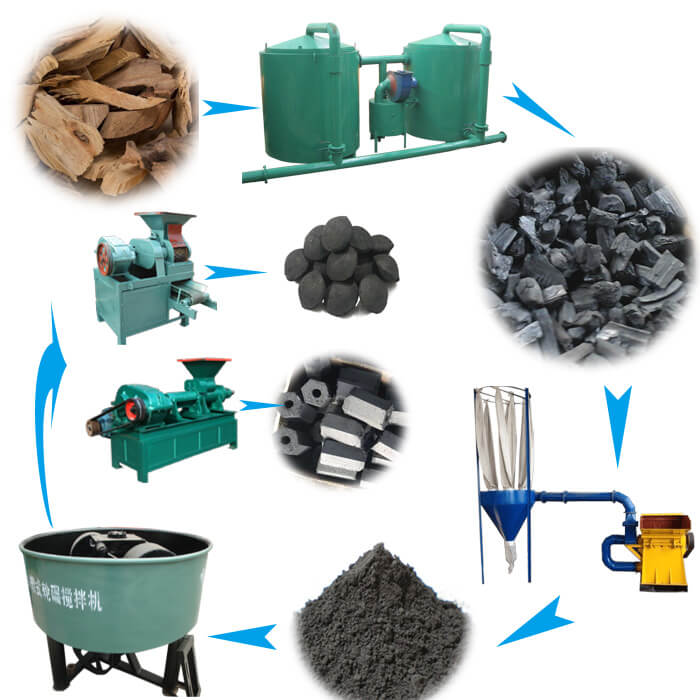


Charcoal briquettes production line. It is mainly responsible for converting raw materials into usable fuel. Through a series of fine processes, including crushing, screening, mixing, shaping, drying and other steps, it ultimately produces charcoal briquettes with uniform texture and good combustion performance.
In the production of charcoal briquettes, the selection and preparation of raw materials is a crucial link. Generally speaking, raw materials suitable for making charcoal briquettes mainly include plant waste containing cellulose such as wood, bamboo, and paper. Among them, hardwoods such as oak and walnut trees are the first choice. Their wood is hard and dense, and the charcoal briquettes produced have high calorific value and long-lasting burning. The quality requirements of raw materials are also very important. Fresh, dry and impurity-free raw materials are more conducive to the production of high-quality charcoal briquettes.
Effective raw material pretreatment can further improve the production efficiency and quality of charcoal briquettes. Pretreatment mainly includes three steps: cutting, drying and crushing. First, the selected raw materials are cut appropriately through a cutting machine to facilitate subsequent drying and crushing; then, they are dried with professional drying equipment to ensure that the moisture in the raw materials is controlled within 15%; finally, through The pulverizer pulverizes the dried raw materials into suitable particle size. In this way, the pretreated raw materials can be carbonized more evenly during the firing process, thereby producing charcoal briquettes with better quality and higher calorific value.
In industrial production, the crushing and mixing of raw materials are crucial processes. The crushing process of raw materials needs to be precisely controlled to achieve a particle size suitable for production. Particles that are too large will affect the overall quality of the product, while particles that are too small may result in a waste of resources. Therefore, the raw materials must be broken into appropriate sizes through scientific methods.
The next step is mixing. Different raw materials, mixed according to a certain ratio, will directly affect the quality of the final product. For example, in the chemical industry, the proportion of reacting substances directly determines the rate and direction of chemical reactions; in food processing, the combination of raw materials affects the taste and nutritional value of the product.
In general, whether it is crushing or mixing, it is a key link in production. Only rigorous and scientific operation can ensure the quality of the final product.
In the production process of briquettes, pressing the mixed raw materials into briquettes is a crucial step. This process requires delicate technical operations and strict control to ensure the quality of the briquettes. First, the mixed raw materials need to be fed into the briquette machine. The briquette machine is a piece of equipment specially used to press briquettes. It presses raw materials into briquettes of a fixed shape and size through high pressure. In this process, pressure control is very important. Too much or too little pressure will affect the quality of the briquettes. Secondly, the pressed briquettes need to go through a drying and solidification process to improve their hardness and wear resistance. This process needs to be carried out under specific temperature and humidity conditions to ensure the performance of the briquettes. Finally, the formed briquettes need to undergo strict quality testing, including testing of their shape, size, hardness and other aspects to ensure that they meet the requirements for use. In general, the process of pressing the mixed raw materials into briquettes is a complex and delicate process that requires precise operation and strict control. We have professional practical experience in this area, contact us for professional technical guidance.
In the production process of charcoal briquettes, drying after forming is a crucial link. There are various drying methods, such as natural drying, mechanical drying, etc. The choice of drying method often depends on specific production conditions and economic benefits. No matter which method is used, the purpose is to reduce the moisture content in the briquettes.
The degree of dryness has a direct impact on product quality. Briquettes with too high moisture content are difficult to ignite when burned and will produce a large amount of smoke, which not only affects the use effect, but also has a certain impact on the environment. Therefore, moderate drying is a key factor to ensure the quality of briquettes. In addition, the degree of dryness also affects the safety during storage. Overly wet briquettes are prone to mildew or even spontaneous combustion, posing hidden dangers to storage.
In short, proper drying treatment can not only improve the quality of charcoal briquettes, but also ensure their safe storage, thereby meeting the needs of users and protecting the interests of producers.
If you also want to build a charcoal briquette production line, please contact us. We have rich industry experience and a professional technical team that can provide you with a one-stop solution from design, equipment selection to installation and commissioning. Our charcoal briquettes production line adopts advanced production processes and technologies to ensure high quality and high efficiency of products to meet your production needs. In addition, we also provide comprehensive after-sales service to solve any problems you encounter during use, so that you have no worries. Whether you are entering this industry for the first time or you have an existing production line that needs to be upgraded, we will be your ideal partner.
CONTACT US
+8613673361755/+8613633713237
Shenglongjinzhonghuan Building, Zhongyuan District Zhengzhou City, Henan Province, China.